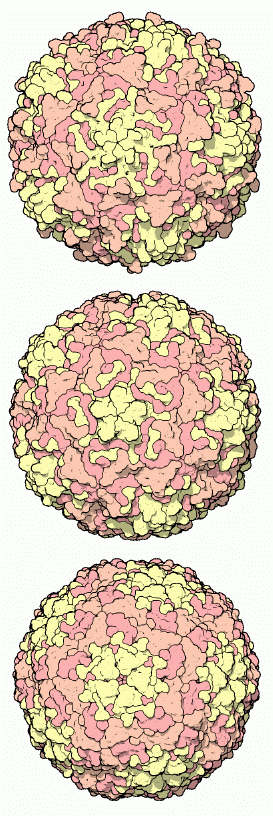|
Inhaltsübersicht | Nanomaschinen | Moleküle | Programme | Kurse | Fun | Links |
||
| > |
Poliovirus and Rhinovirus

Little RNA Viruses
Viruses are biological hijackers. They attack a living cell and force it to make many new viruses, often destroying the cell in the process. Picornaviruses, or "little RNA viruses," are among the most simple viruses. They are composed of a modular protein shell, which seeks out and binds to a target cell surface, surrounding a short piece of RNA, which contains all of the information needed to co-opt the cell's machinery and direct the construction of new viruses. In spite of their simplicity, or perhaps because of it, the picornaviruses are also among the most important viruses for human health and welfare. Three familiar examples are shown here: poliovirus at the top (PDB entry 2plv), rhinovirus at the center (PDB entry 4rhv), and the virus that causes foot and mouth disease in livestock at the bottom (PDB entry 1bbt).Specialization
Poliovirus and rhinovirus have specialized to attack primarily human beings, but they use two different approaches. Poliovirus, which is found in three similar forms, is designed to attack a given person only once. It makes its offspring and then is off to the next person. In most cases, poliovirus causes a simple flu-like disease as it attacks cells in the digestive system. This infection is rapidly cleared up by the immune system. But in about 1 in 100 cases, the virus spreads to the nerve cells that control muscle motion, causing paralysis--polio myelitis--as the nerve cells are infected.Rhinovirus, on the other hand, is found in many different forms that attack a given person many times during their life. Each time you get a cold, a different form of rhinovirus (or occasionally, a different type of virus) is attacking. Your body learns how to fight it off, but you are still susceptible to the next form. On average, a person will have a new cold once every two years, so most of us are quite familiar with the symptoms of rhinovirus infection in our nose and respiratory tract. Because they are so simple, picornaviruses can be very stable. Rhinovirus can last for days on your hands and still be infectious. And because the virus is shed from infected people all through the period with symptoms and even for days after, it spreads effectively through contact from person to person.
Vaccines
Antibodies are our major defense against these small, efficient viruses. Vaccines prime the immune system with antibodies, making it ready to fight an infection. In the case of poliovirus, there are two types of vaccines. One is a killed version of the virus, which is slowly killed with formaldehyde over the course of several days so that it is inactivated, but still keeps its proper shape. The second is a weakened, but still live, strain of the virus that has been artificially bred to stimulate the immune system without causing disease. The immune system responds by making antibodies to fight these weakened viruses, leaving it ready to fight the real thing when it comes along.The polio vaccines are one of the triumphs of modern medicine, but many people would say that the lack of a cure for the common cold is one of the great failings. The difficulty of creating a vaccine for the common cold lies in the diversity of rhinovirus. Over one hundred types of rhinovirus have been discovered as they strike people around the world, and new strains appear continually. Rhinovirus is a moving target that is not effectively combated with a single vaccine. Antiviral drugs, however, are a possible solution.
Next: Picornavirus Structure
Last changed by: A.Honegger,